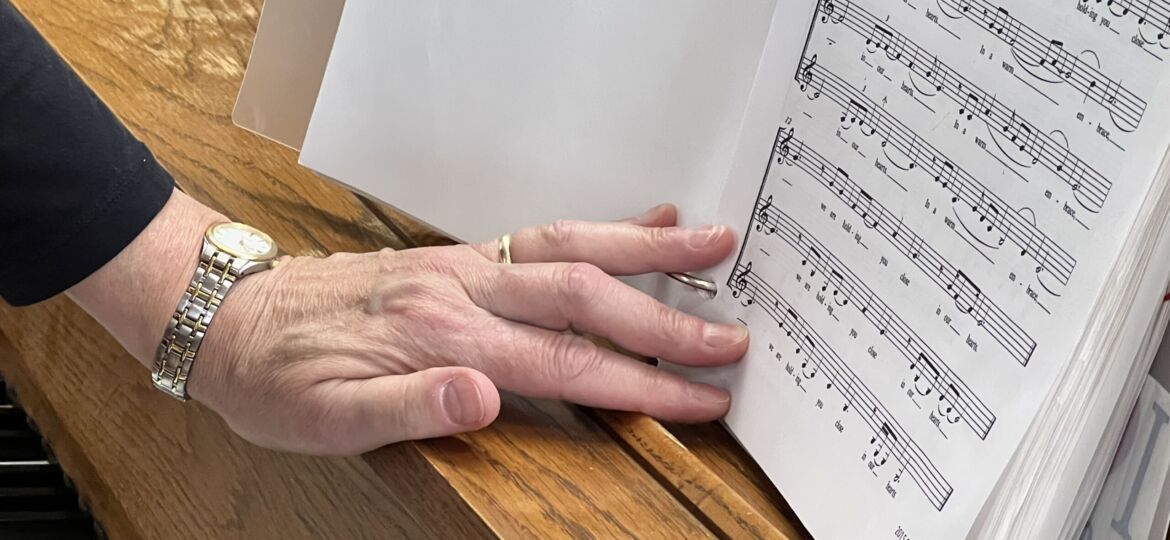
Late on a Sunday afternoon, a key slips into a rear door at Allisonville Christian Church, and three women enter a short hallway. They chat amiably and make their way into a rehearsal room with portable folding tables that are stacked high with sheet music. Choir robes and costumes that give madrigal singing vibes hang to one side. And in another narrow space against a bookcase of hymnals and binders, the bench from the piano sits in the center of three chairs.
A fall-themed table runner is folded in half on top of the bench, and a small golden bowl sits to one side. The women catch up on who from their group is coming that afternoon as they pull black binders from canvas tote bags and arrange themselves on their wooden chairs.
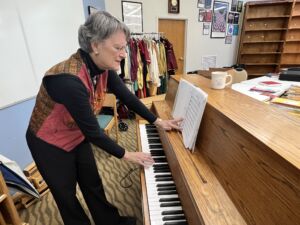
Robin Hess picks up a thin wooden mallet and gently taps the bowl. Three quiet gongs resound through the space for a minute, and the women settle further into the silence.
Then Hess invites the women into a communion of song.
“We’ll just start singing Sanctuary and name the names of people we want to keep in mind,” Hess said.
In her steady, strong soprano Hess begins.
“Lord prepare me, to be a sanctuary…”
Soon, two other women join the song and blend into a three-part harmony that fills the room.
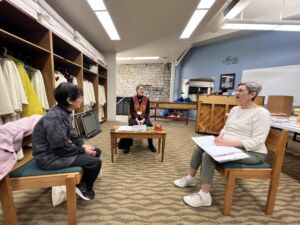
The month’s rehearsal for the Threshold Singers of Indianapolis is underway.
Formally begun in 2000, the Threshold Choir organization idea came to founder Kate Munger nearly a decade earlier, as she was mourning the impending death of a friend whom she described as “a really lovely man. He was a quiltmaker, a homemaker, a domestic person, a collector of friends, a lover of friends, a delightful, delightful man.”
Munger, who lives in northern California, sat by the man’s bedside as his fight with AIDS was ending, and those last days were anything but peaceful. She tried to find something to soothe him, and whether it was instinct or some type of intervention, she turned to singing.
Once she began, she almost instantly felt herself become more at peace. Very soon her friend’s thrashing dissipated, and he became calm, too.
So she sang.
And sang.
And sang.
For nearly three hours, Munger kept up the steady stream of quiet music.
“At the end, I felt like I was in an altered state, and he was completely peaceful, too,” Munger said.
The experience Munger had at that bedside stayed with her and resurfaced when she was on a road trip in Montana in the late 1990s, when she began thinking about all the animals that were dead along the highway. She turned off her radio and began a quiet song of sendoff, her way of appreciating the beauty and majesty of those animals’ lives in a world everyone shares.
Once again, the intentional act of singing over a soul’s departure was a visceral experience. And this time, it would become an international movement.
Singing Peace
Munger bought a computer and started to talk and educate women in her various community circles about singing souls into eternity. The idea was almost immediately embraced, and six months in she had two choirs in two cities. Six months later, she had two more active choirs. Then two more, and today, there are nearly 200 Threshold Choirs active around the globe.
Munger said the singing comforts the people caring for a loved one, sometimes as much or more than the person who is dying.
“I think the tendency for people, for caregivers of someone who is dying, is to give care and to do. To scurry around and clean up and make food and make sure the person is comfortable and to just do, do do, do,” Munger said.
“But instead, there’s really this opportunity when someone’s last few days or hours are there, to sit quietly, to breathe together, to indulge in memory sharing if that’s possible with that person, to read poetry, or in our case, to sing. That’s what it looks like to be really present, really attentive, really focused, really grateful, really honored to be in these last precious moments of someone’s life.”
Munger said the choir’s presence often gives people permission they didn’t know they needed to accept the loss that’s coming.
“It changes at every bedside, with every group of people… but once you sit down at the bedside of someone who is dying you’re saying, ‘Yeah, this is happening. There’s no wiggling out of this one,’” Munger said.
“The lyrics, the repetitive quality of the words, the serene quality of the songs, the directness of the communication, the silence out of which the singing begins and into which the singing ends — all of these are modeling for people, these are the moments that matter.
“This is a moment in your life you won’t forget.”
Uncommon Kindness
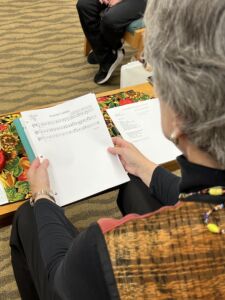
Deanna Roberts-Blair, who sings with Hess in the Indianapolis choir, said part of the opportunity and the responsibility of the threshold singers is to read the room the group enters — to provide the care needed at that moment, for that specific visit.
“Sometimes (patients) are very lively, and they’re interacting with us. And sometimes … we have memory care patients who aren’t very reactive, or patients who are in transition. So really, just trying to send them the kind of energy that they need,” Roberts-Blair said.
Though the singers may not know how their songs are being heard, caregivers say they think the music makes a difference.
Lucy Riegel provides care for a woman at Marquette, a long-term and rehab facility on the city’s northwest side. She is convinced the music soothes her patient — even though much has changed for the woman.
“In earlier months, she responded physically to the song and often clapped at the conclusion of each song,” Riegel said. “Lately, she just keeps her head down… I think she is listening but unable to respond.
“I hope — and believe — she is enjoying the song.”
It’s often impossible to know exactly how a person got to the point in their life when a choir visits, Hess said.
“We don’t always really know their situations. Sometimes a song will call up a lot of memories, you know, and if someone is getting teary, we ask if they want us to continue.”
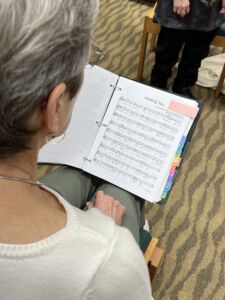
Most often, she said, the patients want the music to go on. The women work to find songs in their repertoire that might be particularly resonant with the patients and their families, and Mary Pendexter said taking a person’s past into consideration before they sing makes the choir’s efforts last beyond those moments in someone’s room.
And not just for the recipients of the songs.
“If they’ve told us something about themselves, I find myself thinking about their life and what they’ve lived through,” Pendexter said.
Those thoughts remain long after the last note has faded. That space in between the giving and receiving of the songs can be hard at times. But that space is where the magic, as Munger calls it, happens.
“They see us singing together… being vulnerable, being focused on this moment, devoted to this moment, responding to this moment,” Munger said. “We on purpose don’t censor our emotional response. It’s important to show people — this is a moment for emotion.”
Like the others, Hess said this kind of service to others stays with her as she sometimes finds herself thinking about those she’s sung to in the past.
“Sometimes we don’t really know, but we get a sense that we’re singing for someone whose family is far away or who doesn’t have family, and then it’s even more important to go in and spend some time,” Hess said.
“I see it as a blessing and a privilege to be able to spend a little bit of time, or offer a moment of comfort that they don’t receive in any similar way. I don’t feel like it’s a burden, I really do feel like it’s just the opposite – being able to see a family like that, it’s a moment of intimacy and privilege to be there.”
All of our content—including this article—is completely free. However, we’d love if you would please consider supporting our journalism with an Indy Maven Digital membership.






